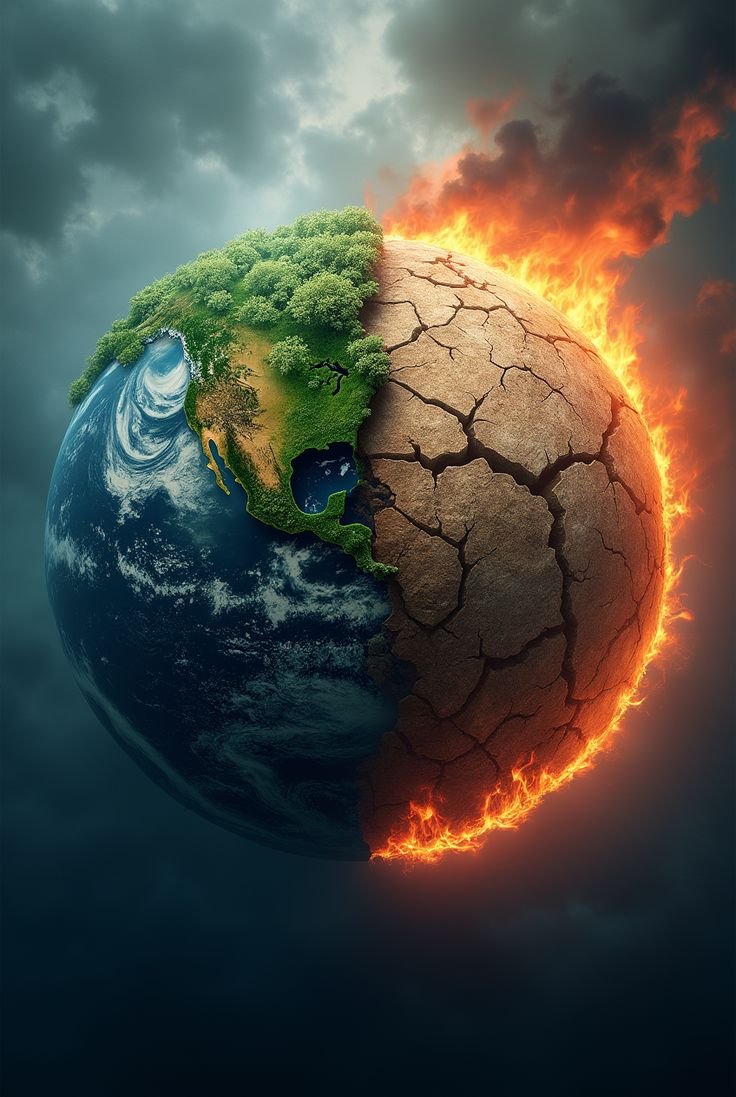Introduction: The Ocean–Climate Connection
Our oceans are the heart of Earth’s climate system. They absorb over 90% of the excess heat caused by greenhouse gas emissions, regulate weather patterns, and support an incredible diversity of life. However, this vital global resource is under severe threat. How climate change is reshaping our oceans is a concern that affects every corner of the planet. From rising sea levels to dying coral reefs, the consequences are real—and they’re happening now.
Ocean Warming: A Silent Crisis
One of the most immediate impacts of climate change on our oceans is the rapid increase in sea temperatures. Oceans act as a buffer by absorbing heat from the atmosphere, but this comes at a cost. Rising temperatures disrupt marine ecosystems, altering species migration, breeding patterns, and food chains.
Fish that once thrived in cooler waters are migrating toward the poles. Plankton—the foundation of the marine food web—is declining in some areas due to warmer temperatures. Ocean warming also increases the frequency and intensity of marine heatwaves, which have devastating consequences for coral reefs and marine biodiversity.
Melting Ice and Rising Seas
The melting of polar ice caps and glaciers is accelerating due to climate change, contributing to sea level rise around the globe. As ice on land melts and flows into the sea, coastal communities face increasing risks of flooding, erosion, and saltwater intrusion into freshwater sources.
Islands in the Pacific and coastal cities like Miami, Venice, and Dhaka are already experiencing the reality of how climate change is reshaping our oceans. Entire nations may become uninhabitable, triggering climate migration on an unprecedented scale.
Ocean Acidification: The Invisible Threat
The oceans absorb about 30% of the carbon dioxide (CO₂) we release into the atmosphere. While this helps slow global warming, it triggers a harmful process called ocean acidification. When CO₂ dissolves in seawater, it forms carbonic acid, lowering the pH of the ocean and making it more acidic.
This acidification weakens the shells and skeletons of marine organisms such as corals, mollusks, and some types of plankton. Coral reefs, already stressed by warming waters, face a double threat as acidification hinders their ability to grow and recover, endangering the countless species that rely on them.
Coral Bleaching: Reefs in Peril
Coral reefs are among the most biologically rich and economically valuable ecosystems on Earth. However, they are highly sensitive to temperature changes. When waters get too warm, corals expel the algae (zooxanthellae) that live in their tissues and provide them with food through photosynthesis. This leads to coral bleaching, a condition that can result in widespread coral death.
Mass bleaching events are becoming more frequent and severe. The Great Barrier Reef, the world’s largest reef system, has suffered multiple mass bleaching events in recent years, with some parts experiencing up to 90% coral mortality. The loss of reefs threatens marine biodiversity, fisheries, and tourism-based economies.
Shifts in Ocean Currents
Ocean currents are driven by wind, Earth’s rotation, and differences in water density, which are influenced by temperature and salinity. These currents play a crucial role in regulating the global climate by distributing heat across the planet.
Climate change is disrupting these currents, particularly the Atlantic Meridional Overturning Circulation (AMOC), which includes the Gulf Stream. A slowdown of AMOC can cause severe weather shifts, colder winters in Europe, more intense storms in North America, and even disruptions to monsoon systems in Asia. These changes underscore how climate change is reshaping our oceans in deeply interconnected ways.
Marine Biodiversity at Risk
As ocean conditions change, many marine species struggle to adapt. Warmer waters, acidification, reduced oxygen levels, and habitat destruction create hostile environments for countless marine organisms. Some species migrate to cooler regions, while others face extinction.
Iconic animals like sea turtles, whales, and polar bears are at increased risk due to shifting habitats and shrinking food supplies. Coral reefs, kelp forests, and seagrass meadows—critical nurseries for marine life—are vanishing, causing a ripple effect throughout the marine food web.
The Human Impact: Fisheries and Food Security
Millions of people worldwide rely on the ocean for food, employment, and economic stability. Fisheries support the livelihoods of nearly 60 million people and supply 17% of global protein consumption. But climate change is threatening this lifeline.
Fish stocks are migrating to new areas, making traditional fishing grounds less productive. Ocean acidification affects the growth of shellfish, a staple in many coastal communities. Reduced catch sizes and declining fish populations jeopardize food security, particularly in developing nations heavily dependent on marine resources.
Ocean Deoxygenation: The Growing Dead Zones
As oceans warm, their ability to hold oxygen decreases, leading to a phenomenon known as ocean deoxygenation. Additionally, increased nutrient runoff from agriculture and wastewater boosts algal blooms, which consume oxygen and create “dead zones” where few marine organisms can survive.
These low-oxygen zones are expanding, particularly in coastal areas. The Gulf of Mexico, the Arabian Sea, and parts of the Baltic Sea have seen significant increases in hypoxic (low oxygen) conditions. This is yet another example of how climate change is reshaping our oceans and reducing their ability to support life.
Coastal Erosion and Extreme Weather
Climate change intensifies storms and hurricanes, which are fueled by warmer ocean waters. Coastal erosion and storm surges are becoming more destructive, placing lives and infrastructure at risk. Rising sea levels further exacerbate these impacts, especially in low-lying areas.
Flooding caused by rising oceans is no longer a distant threat—it’s happening now. Coastal cities are investing billions in sea walls, stormwater management, and climate adaptation strategies to deal with the realities of more frequent and extreme weather events.
Marine Ecosystem Collapse: A Warning Sign
Scientific models predict that if current trends continue, many marine ecosystems may face collapse by the end of the century. The combination of warming, acidification, deoxygenation, and overfishing creates an unsustainable burden on the ocean’s resilience.
Tipping points may be reached sooner than expected, triggering irreversible changes in ocean chemistry and ecology. Understanding how climate change is reshaping our oceans is essential to avoiding these catastrophic outcomes.
Innovative Solutions and Global Efforts
Despite the grim outlook, there is hope. Global initiatives like the Paris Agreement, the United Nations Ocean Decade (2021–2030), and regional conservation programs are mobilizing resources to protect and restore marine ecosystems.
Efforts include expanding marine protected areas, reducing carbon emissions, investing in sustainable fisheries, restoring mangroves and coral reefs, and promoting ocean literacy among the public. Technological innovations such as satellite monitoring, artificial reefs, and carbon capture in marine environments are also part of the solution.
The Role of Individuals in Ocean Conservation
Everyone has a role to play in protecting our oceans. Simple actions such as reducing plastic use, choosing sustainable seafood, supporting clean energy, and advocating for climate action can make a significant difference.
Education and awareness are key. By understanding how climate change is reshaping our oceans, individuals and communities can become powerful allies in the fight against ocean degradation. Every choice matters, from the products we consume to the policies we support.
Conclusion: Protecting the Blue Heart of the Planet
Our oceans are not just vast bodies of water—they are the lungs of the planet, the cradle of life, and a source of food, beauty, and wonder. But they are changing rapidly under the pressure of climate change. From rising sea levels to mass coral bleaching and marine species extinction, the signs are clear.
It’s not too late to act. With bold leadership, international cooperation, and informed citizens, we can slow and eventually reverse the damage. The story of how climate change is reshaping our oceans is still being written—let’s make sure it ends in restoration, not collapse.


